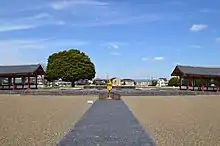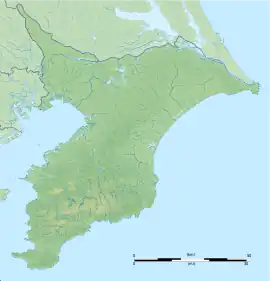| Kazusa Kokubun-niji | |
|---|---|
上総国分尼寺 | |
 Kazusa Kokubun-niji Kondō site | |
| Religion | |
| Affiliation | Buddhist |
| Status | ruins |
| Location | |
| Location | Ichihara, Chiba |
| Country | Japan |
 Shown within Chiba Prefecture  Kazusa Kokubunni-ji (Japan) | |
| Geographic coordinates | 35°30′01″N 140°07′05″E / 35.50028°N 140.11806°E |
| Architecture | |
| Founder | Emperor Shōmu |
| Completed | 741AD |
The Kazusa Kokubun-niji (上総国分尼寺跡) is the ruins of a Buddhist nunnery located in the city of Ichihara, Chiba, Japan which was part of the provincial temple complex ("kokubunji") of former Kazusa Province.The temple ruins were designated a National Historic Site in 1983, with the area under protection expanded in 1985.[1]
Overview
The Shoku Nihongi records that in 741, as the country recovered from a major smallpox epidemic, Emperor Shōmu ordered that a monastery and nunnery be established in every province, the kokubunji (国分寺).[2][3]
The Kazusa Kokubun-niji was located on the northern bank of the Yōrō River, in an area with a high concentration of kofun and ancient sites, and is separated from the Kazusa Kokubun-ji, which was located a short distance to the southwest, by a shallow valley. After several archaeological excavations starting in 1948, the layout of the temple was confirmed. The total area of the temple complex was 372 meters north-to-south by 285 meters east-to-west, for a total area of 123,000 square meters, making it the largest nunnery in the kokubunji system yet discovered. The central enclosure, containing the main structures of the nunnery, measured 200 meters north-to-south by 170 meters east-to-west. The foundation stones for the South Gate, Middle Gate, Kondō, Lecture Hall, Cloisters, bell tower, sutra tower, and the residential building for the nuns have been found. In addition, there are traces of a metal workshop, medicinal plants garden and infirmary. In 1996 the Middle Gate and part of the Cloister were restored, and a museum (the Kazusa Kokubunnji Temple Ruins Exhibition Hall (上総国分尼寺跡展示館, Kazusa kokubuniji-ato tenji-kan) was built on the site to display various artifacts that have been unearthed. It also contains a large diorama showing how the temple complex may originally have looked. The site is a ten-minute walk from the Ichihara City Hall bus stop on the Kominato Railway Bus from Goi Station on the JR East Uchibo Line.[4]
 Site of Kondō
Site of Kondō Restored Cloisters
Restored Cloisters Cloisters, interior
Cloisters, interior Cloisters, exterior
Cloisters, exterior Restored Middle Gate
Restored Middle Gate Site of Lecture Hall
Site of Lecture Hall Excavated artifacts
Excavated artifacts Site of Sutra Tower
Site of Sutra Tower Site of Bell Tower
Site of Bell Tower Site of East Gate
Site of East Gate
See also
References
- ↑ 上総国分尼寺跡. Cultural Heritage Online (in Japanese). Agency for Cultural Affairs. Retrieved 25 May 2020.
- ↑ Brown, Delmer M. (1993). Cambridge History of Japan vol. I. Cambridge University Press. p. 255.
- ↑ Yiengpruksawan, Mimi Hall (1998). Hiraizumi: Buddhist Art and Regional Politics in Twelfth-Century Japan. Harvard University Press. pp. 22f.
- ↑ Isomura, Yukio; Sakai, Hideya (2012). (国指定史跡事典) National Historic Site Encyclopedia. 学生社. ISBN 4311750404.(in Japanese)
External links
- Prefectural Tourist Information (in Japanese)
- Ichihara City home page (in Japanese)